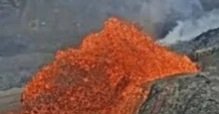Kilauea erupts again, marking 31st Eruption since December

Hawaii’s Kilauea volcano erupted once again on Friday, sending lava arcs up to 100 feet (30 meters) into the air and across its summit crater. This marks the 31st eruption since December, reinforcing its status as one of the world’s most active volcanoes.
The eruption began in the morning from the north vent inside the crater, with lava starting to overflow hours later. By afternoon, it was shooting lava fountains. No homes were at risk, as the activity remained confined within the crater.
Some lucky visitors at Hawaii Volcanoes National Park got a direct view of the spectacle. Others tuned into live video streams set up by the U.S. Geological Survey. Park volunteer Janice Wei, who documents the eruptions, compared the roaring sounds of the lava to jet engines or crashing waves and said she can feel the heat from over a mile away.
"Each eruption feels like front-row seats to nature’s most stunning show,” she said.
How It Works: The Science Behind the Eruption
Magma from deep within the Earth is feeding a chamber beneath Halemaʻumaʻu Crater at around 5 cubic yards (3.8 cubic meters) per second, inflating it like a balloon. The magma then rises through the same underground path used since December, bursting through narrow vents and sometimes reaching heights over 1,000 feet.
The build-up of pressurized magma beneath degassed magma creates explosive fountains, much like popping a shaken champagne bottle. This pattern of repeated lava fountains has only happened four times in 200 years — previously in 1983, 1969, and 1959.
Scientists can’t yet say how long this eruption will last. Kilauea’s 1983 eruption began similarly, later shifting to a continuous lava flow from a lower elevation vent that lasted until 2018. A similar change could happen again — or the eruption could simply end if magma levels drop.
Using seismic and ground tilt sensors, experts can usually predict an eruption several days to a week in advance.
Geologist Steve Lundblad noted that recent lava fountains have been shorter, possibly due to widening of the vent, which reduces the pressure — though the eruptions remain visually dramatic.
A Cultural Connection
To many Native Hawaiians, lava is not destructive but creative — forming new land and grounding cultural traditions. Huihui Kanahele-Mossman, head of the Edith Kanakaʻole Foundation, visits the crater to observe the lava and connect it to ancient chants and hula traditions honoring Pele, the volcano goddess.
She offers chants and gifts like kava and lei at the crater. “As dancers and storytellers, we carry the history described in these chants,” she said. “Seeing the lava in real life makes those stories come alive.”
Planning a Visit
Park attendance has been up every month in 2025, partly due to ongoing eruptions. In April, visitors increased by 49% over the same month in 2024.
Park officials urge visitors to check for real-time alerts from the U.S. Geological Survey, as some eruptions have lasted just 10–12 hours. Safety is critical — trails and viewing platforms are safest, as unseen cracks or unstable ground near the crater can be dangerous. Volcanic gas and ash also pose health risks, especially at night, so flashlights are essential.



